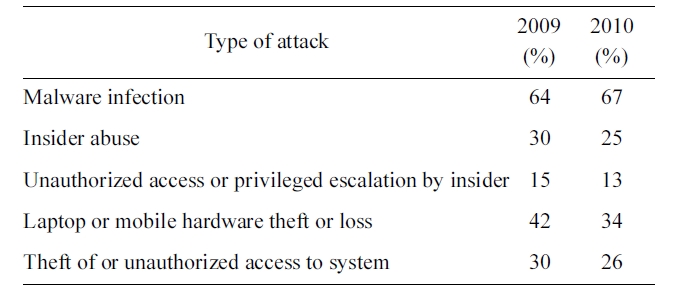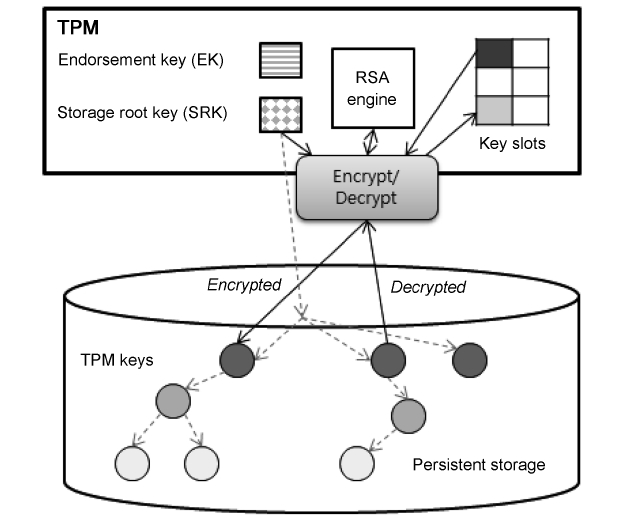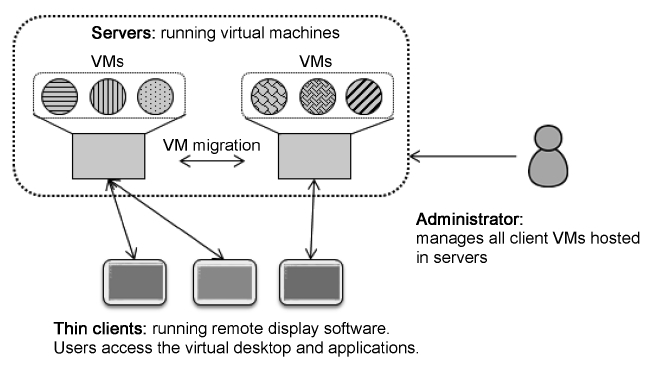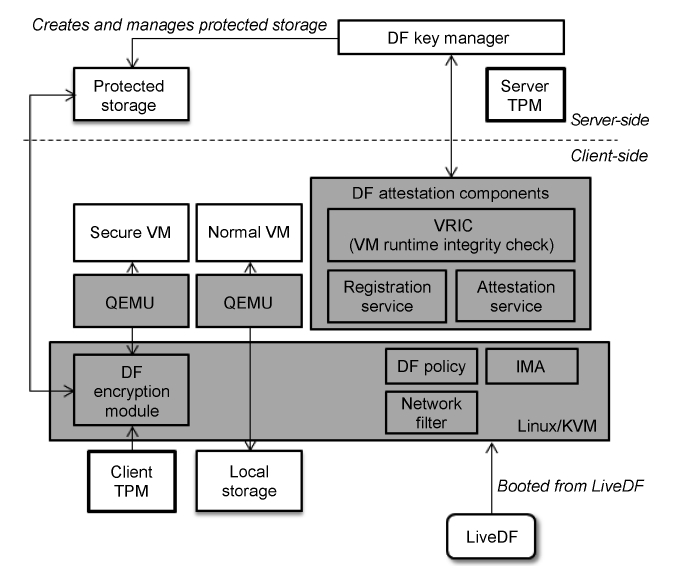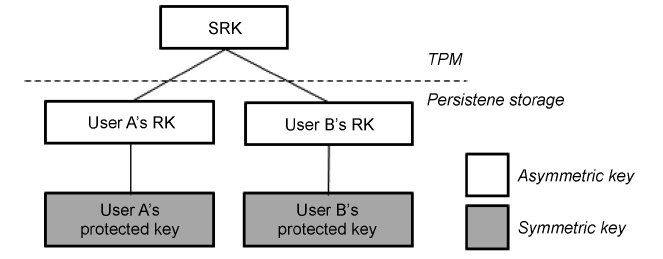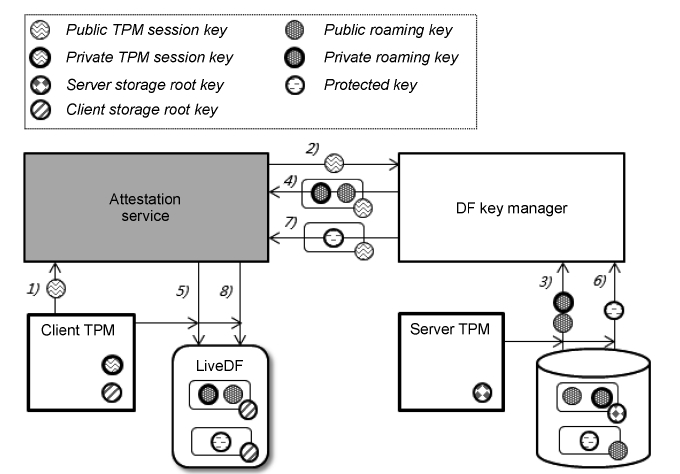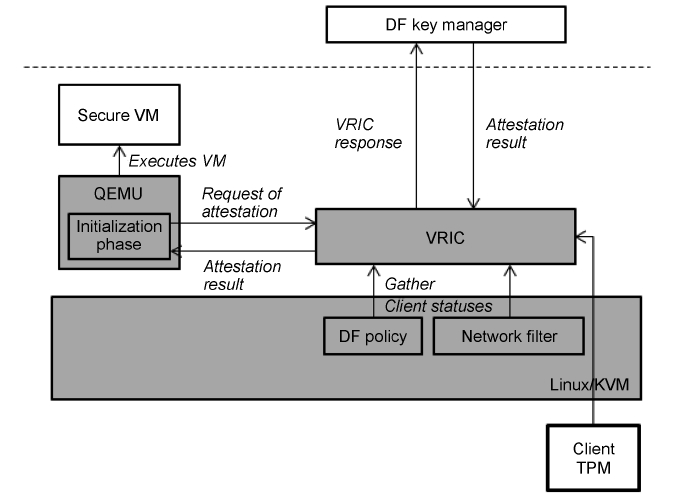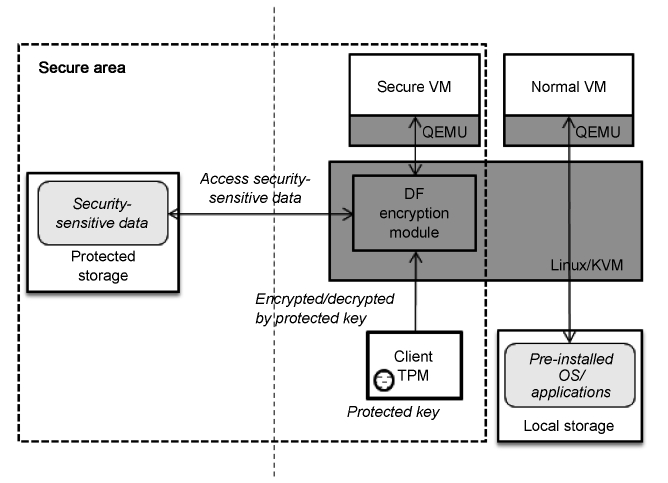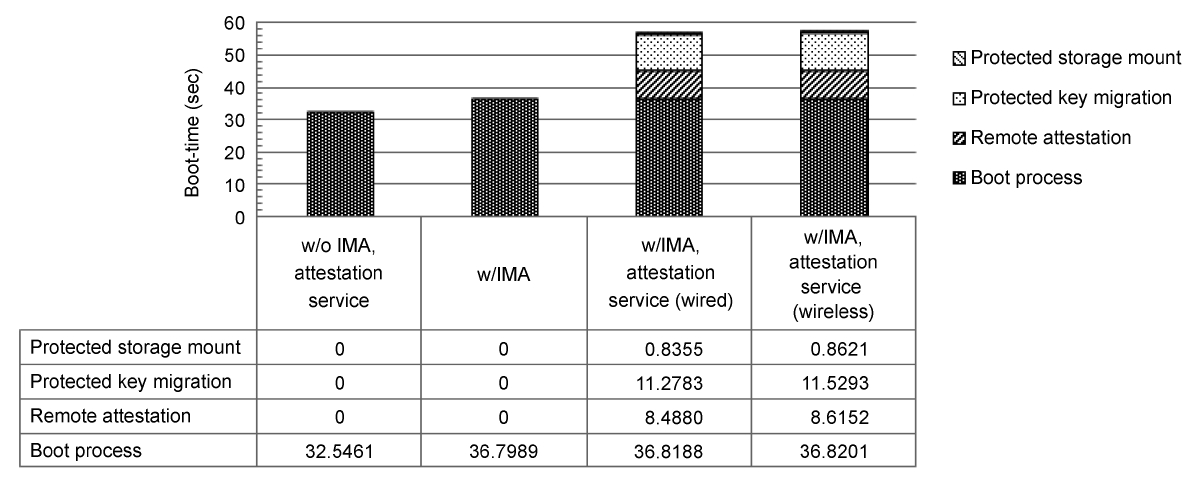IT administrators have to handle various security issues, such as security-sensitive data leakage by malicious insiders, updat-ing the secure system, and installing security patches. Accord-ing to the most recent CSI Computer Crime and Security Survey [1], respondents have experienced the following types of attacks; malware infection (67%), laptop theft (34%), insider abuse (25%), unauthorized system access (26%) and unautho-rized access or privilege escalation by insider (13%) in 2010 (Table 1).
Virtual Desktop Infrastructure (VDI) [2, 3] is one of the solu-tions to these issues. In VDI, the execution images including the OS and libraries are managed centrally in a server and each exe-cution image (a.k.a., Virtual Machine [VM] image) is executed on a virtual machine in the server. Each client will access its own virtual machine running on the server through remote desktop protocols like MS RemoteFX [4], Citrix ICA [5], and VMWare PCoIP [6]. VDI assumes a thin client device model, which has limited functionalities, so the user performance of the VDI is highly dependent on the remote desktop protocol sup-ported. There are two important benefits of VDI: central man-agement of all client VMs and storage of each client’s security-sensitive data in a server. All the client VM images are managed centrally in a server, thus enabling uniform installation of secu-rity patches etc. In addition, a user is not allowed to store any data in a local storage of a client device, but must store it in the remote storage of the server. Accordingly, VDI has been widely
adopted to centrally manage security-sensitive data, thus enabling secure protection of data. In order to overcome the limited functionalities of a thin client, VDI usually is based on thick client devices such as laptops.
However, it is still possible that the data stored in the central storage can be leaked by malicious insiders (e.g. server admin-istrators), because they can have privileged control of the cen-tral server and storage. Moreover, data leakage could occur due to malicious software installed in mobile client devices and unauthorized access to the central server.
In this paper, we present Data Firewall, a security framework that protects security-sensitive data based on Trusted Platform Module (TPM) [7] and client-side virtualization. Data Firewall adopts remote attestation [8, 9] and Protected Storage [10] techniques based on TPM to prevent data leakage by malicious insiders, although they have privileged control. There are two types of execution domains defined in Data Firewall: Normal VM and Secure VM. In Normal VM, a user can execute any applications installed in the laptop in the same manner as before. A user can access security-sensitive data only in the Secure VM, for which the integrity (i.e., virtual machine image) should be checked in advance. All the security-sensitive data are stored in Protected Storage, for which the access keys are managed by TPM.
In this section, we provide a brief survey of TPM, the integ-rity measurement approach for trusted computing in a virtual-ization environment, and VDI, which are used to develop Data Firewall.
TPM is a security chip, proposed by the Trusted Computing Group (TCG) [11]. It supports capabilities such as remote attes-tation and sealed storage. Remote attestation creates hash chains of the hardware and software platform configuration at boot time. This allows a Trusted Third Party (TTP) [12] to ver-ify that the platform environment has not been changed. Sealed storage provides support for data encryption with a platform state in the TPM, called sealing. The TPM must be in the cor-rect state in order for the data to be decrypted, called unsealing. Also, the TPM supports the TPM Attestation Integrity Key (AIK), which is a private key (AIK?1) stored inside the TPM. It is only used to sign the current values of the TPM’s Platform Configuration Registers (PCRs). A challenger can get the AIK public key from the AIK certificate.
The TPM contains a volatile storage for protecting data and
keys entrusted to it. This storage holds currently used keys, but it is very small, thus unused keys are encrypted with the storage key and stored in a persistent storage, such as a hard disk. The storage key is encrypted with the Storage Root Key (SRK), which is generated during the process of taking logical owner-ship of the platform and is embedded in the TPM. Fig. 1 shows the TPM Key hierarchy.
The Terra [13], proposed by Stanford University, was the first approach that tried to adapt attestation and VM identity in a virtualization environment for trusted computing. It provided a novel concept for well-defined remote attestation and authenti-cation, and it involved building a certificate chain using TPM. Moreover, Terra defined two VM concepts, open-box VM and closed-box VM. Open-box VMs can run commodity operating systems and customize the appearance of today’s general-pur-pose platforms. Closed-box VMs provide the functionality of implementation on a dedicated closed platform. Hypervisor pro-tects the privacy and integrity of a closed-box VM’s contents, and the closed-box VM can only start to run after attestation.
In VDI, operating systems and applications are running inside virtual machines that reside on servers. Operating sys-tems inside VMs are referred to as virtual desktops. Users access virtual desktops and applications from a thin client as a terminal. They use applications as if they were loaded on local systems, but the difference is that they are centrally managed. Desktop administrative and management tasks are significantly reduced. Applications can be quickly added, upgraded and patched. Also, data is stored in the central storage, thus data is easier to manage [14]. Fig. 2 shows the simple VDI architecture.
Assumptions: We assume that the target client and server are equipped with the TCG’s hardware (i.e., BIOS with Core Root of Trust for Measurement [CRTM] and, TPM or Mobile Trusted Module [MTM][15, 16]). Thus, target client and server can be booted through TCG’s trusted boot process. Also, we assume that Kernel Virtual Machine (KVM) [17] is installed in each cli-ent or LiveDF.
Threat Model: Our framework aims to protect security-sensi-tive data in thick client mobile devices or central servers from malicious insiders and outside attackers. We assume that mali-cious insiders and attackers can use a privilege to access the central storage and the client root anytime. Furthermore, they can mount attacks via remote attestation and compromise the policy of Secure VM for access to the protected storage with the root privilege. Finally, a user has various client device types such as desktop, laptop and other mobile devices. We assume that the user can lose their mobile devices or that attackers can steal them in order to access security-sensitive data.
Fig. 3 shows the architecture of Data Firewall. The server of Data Firewall has Data Firewall Key Manager (DFKM), Pro-tected Storage, a client information database, and TPM. DFKM
supports VM image management, remote attestation, and key management for Protected Storage. The server TPM creates a Protected Key for an encryption key of each Protected Storage.
The client of Data Firewall is booted from LiveDF, which is a bootable mobile device, and it has all the Data Firewall compo-nents of the client. The client TPM supports a trusted boot pro-cess with DF attestation components and Integrity Measurement Architecture (IMA) [9]. Furthermore, it stores the Protected Key migrated from the server TPM. After remote attestation, a user can access the encrypted data with the Protected Key through DF Encryption Module in Secure VM. Also, the user can execute any applications installed in the client in Normal VM.
We discuss how to build the trusted computing environment in Data Firewall, and how to access security-sensitive data pro-tected from malicious insiders and attackers.
1) Registration Process: A user has to create a LiveDF device through the user registration process of DFKM when using Data Firewall for the first time. DFKM registers a user’s information (i.e., user ID, password, physical LiveDF ID, and LiveDF Key) with the client information database. Moreover, DFKM creates the user’s Protected Key and LiveDF Key using the server TPM. Protected Key is a unique key for each Pro-tected Storage. It is used to encrypt and decrypt the data in Pro-tected Storage through the DF Encryption Module. Finally, DFKM installs Data Firewall components and a LiveDF key to the LiveDF. The LiveDF key is used for matching between the user, client and LiveDF. The user’s client is booted from the LiveDF the first time, and then the registration service is acti-vated. We define it as the client registration process. The regis-tration service gathers the client’s initial status (i.e., the measurement log and Platform Configulation Register [PCR] values in TPM). This information is created by CRTM, a trusted bootloader [18, 19] and IMA through a trusted boot process. We measure the Linux kernel, KVM, initial ramdisk, QEMU [20, 21], and DF attestation components for building TCB. We extend PCRs in the client TPM with these measurements and make the measurement log. The registration service sends the registration request to DFKM and gets a 160-bit nonce value (N). The service uses TPM Quote commands to create an DFResponse (Equation 1) and sends this response to DFKM, which decrypts an encrypted ID message in this response with LiveDF Key and, attests LiveDF ID and user ID/PW. Finally, DFKM registers this information to the user’s information data-base and uses it for verifying the client next time.

2) Attestation Process: After the registration process, the attestation service is activated at the next boot time. We define this as client attestation. The attestation service gathers the cli-ent statuses during boot time. This is similar to the client regis-tration process. The service sends the attestation request to DFKM and gets a 160-bit nonce value. It uses the TPM Quote command to create an DFResponse (Equation 1) and sends this response to DFKM, which verifies the current client status by comparing it with the initial client status. If the client is trusted,
then DFKM sends the result, a DF policy for Secure VM, and a request for TPM Key Migration, which is the process of migrat-ing a key from one TPM to another. The user’s Protected Key is migrated from the server TPM to the client TPM. Fig. 4 shows our TPM key tree. SRK is the root of the TPM key and never leaves the TPM (Non-Migratable Key). We create a Roaming Key (RK) pair, which is a child key of SRK that is migratable and asymmetric. An RK pair is encrypted by the public SRK, and stored in a persistent storage. Furthermore, we create a Pro-tected Key, which is a child key of RK that is migratable and symmetric. The Protected Key is encrypted by the public RK, and stored in a persistent storage.
Fig. 5 shows the Protected Key Migration process. After receiving the request, 1) the attestation service creates a TPM key pair, called the TPM Session Key Pair; 2) the service sends the TPM Session Public Key to DFKM; 3) DFKM loads the RK pair and the RK certificate from the server TPM; 4) DFKM rewraps the RK pair and the certificate with the TPM Session Public Key using the server TPM, and then they are sent; 5) The attestation service decrypts this data with the TPM Session Pri-vate Key using the client TPM and registers the RK pair with the client TPM. After RK migration; 6-8) the attestation service starts the Protected Key migration process between the server TPM and client TPM in the same manner.
After the Protected Key Migration process, the attestation service sets the network filter with the DF policy. Finally, it runs a Normal VM and a Secure VM with the DF policy using KVM and QEMU.
3) Virtual Machine Runtime Integrity Check (VRIC): We need to ensure that we run a Secure VM with a trusted DF pol-icy. We make a VRIC module and add some codes for creating a link between QEMU and VRIC to the initialization phase of QEMU. VRIC is similar to the attestation service, but it is only activated at the running VM. Secure VM is started, and then QEMU enters the initialization phase. In this phase, QEMU checks the VM options and sets the configuration of the VM. Before setting up the configuration of the VM, QEMU sends the VM options to the VRIC module and waits until the comple-tion of attestation. After receiving the attestation request from QEMU, VRIC sends a request to DFKM and gets a 160-bit nonce. Next, VRIC extends PCRs in the client TPM with the DF policy of Secure VM and the configuration of the network filter. VRIC uses the TPM Quote command to create a VRIC response (Equation 2) and sends this response to DFKM.

DFKM makes a comparison between the current and initial client status. Furthermore, it compares the current client DF policy and network filter configuration to the initial configura-tion in the client information database. The DF policy and net-work filter configuration includes the VM configuration, such as allowed networks and devices for VM. If the current status is trusted, then DFKM sends the result and VRIC returns a suc-cess message to QEMU. This process is shown in Fig. 6.
4) Protected Storage: In Normal VM, the VM image is booted from the operating system pre-installed in a client device, and a user can execute any applications installed in the device. All the executions in Normal VM are based on the phys-ical local storage. In Secure VM, the VM image is booted from a VM image stored in the Data Firewall server for a specific cli-ent. A user in Secure VM can access the security-sensitive data only after the VM image is attested according to the DF policy and VRIC by the Data Firewall server. As previously explained, all the security-sensitive data are encoded by the DF Encryption
Module and stored in the space called Protected Storage. A symmetric key called Protected Key is created for a client or a group of clients by the Data Firewall server, and the key is dis-tributed to the DF Encryption Module of each legal client. Key management and distribution are based on TPM both in clients and the server. This process is shown in Fig. 7.
We evaluate how our framework achieves the goals of pro-tecting security-sensitive data from various types of attacks experienced (Table 1).
1) Malware Infection and Unauthorized System Access: First, we ensure that the adversary cannot compromise the TCB of our framework to influence its output. The Root of Trust is started from the CRTM in our framework. The Linux/KVM, DF attestation components, and QEMU are measured during the TCG’s trusted boot sequence. The integrity of each component is extended to TPM’s PCRs. Their integrity can be attested using the TPM’s standard attestation process. Thus, any attempt to compromise the TCB of our framework will be detectable, regardless of the root privilege of the adversary. Moreover, this can prevent malwares installed in mobile devices used as Data Firewall clients. Because malwares should compromise the TCB of our framework, they would be detectable during the attestation process. We also ensure that the adversary cannot compromise the LiveDF. This has all the Data Firewall compo-nents of the client and LiveDF Key, thus it has to be protected from any attacks. LiveDF has a unique LiveDF ID and LiveDF Key. LiveDF ID is a physical device ID, such as information about the USB buses in the system. LiveDF Key is created by the server TPM and it is also unique. We register this informa-tion with the user information database with the initial status of the client in the user registration process. Thus any attempt to compromise LiveDF will be detectable during the attestation process. Finally, we can detect the attack compromising DF pol-icy and the configuration of the network filter also. The DF pol-icy and the configuration of the network filter are attested by VRIC when starting a VM. VRIC extends PCRs in the client TPM with this information in order to ensure that the adversary cannot compromise this information. DFKM can attest whether the configuration of the client is trusted or not. Additionally, VRIC gathers this information and reports it to DFKM periodi-cally in order to prevent the Time-of-Check-to-Time-of-Use (TOCTTOU) attack. If the result of the request is false or the connection is closed due to various problems, then the VRIC stops the Secure VM immediately.
2) Insider Abuse and Mobile Hardware Theft: We can pro-tect security-sensitive data in Protected Storage from malicious insiders and outside attackers. Each block of Protected Storage is encrypted by Protected Key and a user can only access the data through DF Encryption Module. The adversary cannot gain access to this key, because it is managed by the TPM and can only be used after the attestation process. We also use the TPM Key Migration technique for protecting against Protected Key leakage on the network. If a user loses their laptop or other mobile devices are used as Data Firewall clients, the adversary cannot access the data, because the Protected Key is only migrated from the server TPM after the attestation process at every boot time. Moreover, a malicious insider can gain unau-thorized access to the Data Firewall server. However, Protected Storage can only be accessed through DF Encryption Module with Protected Key, which can only be obtained using a trusted Data Firewall client. Thus any attempt to leak security-sensitive data and Protected Key can be prevented.
We implemented a Data Firewall prototype on a thick client mobile device, a DFKM, Protected Storage server, and a USB device for LiveDF. A laptop has a 2.4 GHz Intel Core 2 Duo processor with Intel-VT support and 3 GB RAM for a thick cli-ent mobile device. Windows XP is installed on this mobile device for a Normal VM. A server has three 2.83 GHz Intel Xeon processors, 3 GB RAM, and 1 TB hard-disk. LiveDF is a 16 GB USB device. We use 2.6.35.12 Linux/KVM with IMA as the target hypervisor and 0.14.0 QEMU. A Normal VM and a Secure VM consists of Windows XP, one vCPU, and 1 GB RAM. These systems are connected over a 100 Mb Ethernet switch and an 802.11g wireless access point, because a user’s mobile devices or desktops are connected to a wired/wireless network in order to access security-sensitive data in their enter-prise.
We evaluate three aspects of Data Firewall’s performance overhead: 1) the boot time of Data Firewall, 2) the performance overhead of VRIC, and 3) the performance overhead of Pro-tected Storage on Secure VM.
1) Boot Time: We measure the boot time of Data Firewall using BootChart [22]. We examine three cases, kernel booting without IMA and the attestation service, with only IMA, and with IMA and the attestation service. Fig. 8 shows the experi-
mental results. The average boot time is calculated ten times. The first measurement shows the time needed to boot the host system. The second measurement shows the performance over-head of IMA. The third measurement shows the performance overhead of the attestation service in Data Firewall. The attesta-tion service consists of three components: remote attestation, Protected Key migration, and Protected Storage mount. The remote attestation and Protected Key migration techniques have high performance overhead, because they use various TPM commands, such as TPM Quote. However, they are background processes, thus a user can access a user’s client during these processes. Measurements in both wired and wireless networks are almost identical, because the size of attestation messages and Protected Key between the client-server is small.
2) The Performance Overhead of VRIC: VRIC is only acti-vated when starting a VM. The VM starts to run, and then VRIC gathers the current client status. This is similar to the remote attestation process of the attestation service. The experimental results indicate that the performance overhead of VRIC is 8.4912 seconds on average. This performance overhead only affects the initialization phase of VM, but not the VM running time. There-fore, a user can execute applications or access data with almost the same performance in the virtualization environment.
3) The Performance Overhead of Protected Storage: We measure the performance overhead of Protected Storage in the Secure VM using IOMeter [23]. We compare the results of run-ning the benchmark on the Secure VM with Protected Storage and with iSCSI network storage. We compare our secure stor-age system with other types of network storage, such as iSCSI, because we assume that Protected Storage is located on a cen-tral server. In this experiment, Protected Storage in the central server is based on iSCSI. Fig. 9 shows the measured results in terms of average I/O response time for the IOMeter benchmark with 100% random I/Os and 8 outstanding I/Os per target. Pro-tected Storage has a performance overhead, because every block is encrypted and decrypted with Protected Key. However, if the performance difference is less than 10%, this constitutes low performance overhead.
Our contribution in this work is to develop a security frame-work for protecting security-sensitive data from many types of attacks. IT administrators can handle various security issues even if the attacker is a malicious insider in this framework. Despite the fact that our system sets a strong security policy for a user’s client, the user can execute any applications installed in a user’s client in the same manner as before in this framework.
In this paper, we presented Data Firewall, a TPM-based secu-rity framework Data Firewall to centrally manage VM images and protect security-sensitive data in mobile environments.
The Data Firewall is based on the three major functional components of Protected Storage, remote VM image attestation, and key management/distribution protocol for TPM. We have analyzed the security features of the proposed framework and evaluated the execution overhead through a prototype.
In summary, the proposed framework is shown to prevent data leakage by any type of attack including a malicious insider’s attack using TPM capabilities such as remote attesta-tion and key management. Moreover, it has low execution over-head, thus ensuring its practicality in a real-world situation.




